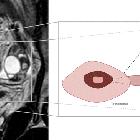müllerian duct
The Müllerian ducts (or paramesonephric ducts) are paired ducts of mesodermal origin in the embryo. They run laterally down the side of the urogenital ridge and terminate at the Müllerian eminence in the primitive urogenital sinus.
In the female, they will develop to form the uterine tubes, uterus, and the upper portion of the vagina; in the male, the vestigial remnant is the appendix testis.
History and etymology
They are named after Johannes Peter Müller (1801-1858), a pioneering German physiologist and comparative anatomist who described these ducts in his text "Bildungsgeschichte der Genitalien" in 1830.
Related pathology
See also
Siehe auch:
- Uterus
- Vagina
- wolffian duct
- Müllerian duct anomaly classification
- Fehlbildungen der Gebärmutter
- Zysten des Müller-Gangs
- Eileiter
- Müller Gang Embryologie
und weiter:

 Assoziationen und Differentialdiagnosen zu Müller-Gang:
Assoziationen und Differentialdiagnosen zu Müller-Gang:







